#mammalogy
Text
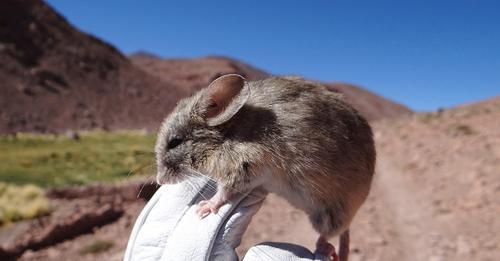
Mice thrive at 6700 m, higher than any mammals were thought able to live
Survey turns up several mouse species living on Andes peaks, breaking records for the highest dwelling mammals
Few places are as inhospitable as the top of Llullaillaco, a 6700-meter volcano on the border between Chile and Argentina.
Winds howl nonstop and no plants live there; daytime temperatures never get above freezing and plummet even more come nightfall. Oxygen levels are just 40% of those at sea level, too low for mammals to live there —or so biologists thought until 3 years ago when a research team captured a live leaf-eared mouse at its summit.
Now new work shows this animal was not a fluke. The team has found other leaf-eared mice on additional volcano tops, and genomic studies of these summit dwellers and their lower elevation relatives confirm the rodents make their homes nearly 7000 meters above sea level, making them the highest dwelling vertebrate found so far. (Some birds soar higher but appear not to dwell at those elevations.)
The team has also come across five other mouse species living above 5000 meters on various mountains in the Central Andes...
Read more: https://www.science.org/content/article/mice-thrive-6700-kilometers-higher-any-mammals-were-thought-able-live
#mouse#rodent#leaf eared mouse#mammal#mammalogy#biology#zoology#animals#nature#south america#mountains#science
1K notes
·
View notes
Text
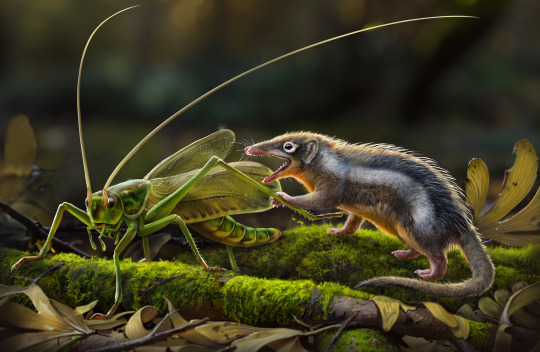
Research alert! New insights into mammalian tooth, jaw, and ear evolution, gleaned from analyzing fossils of two Jurassic-era mammal species from China, are reshaping how scientists think about early mammals. This research, led by scientists at the Museum and the Chinese Academy of Sciences, focuses on two new species of fossil mammals—Feredocodon chowi and Dianoconodon youngi—that offer new evidence about early mammalian evolution.
“Scientists have been trying to understand how the mammalian middle ear evolved since Darwin’s time,” said Jin Meng, a curator in the Museum’s Division of Paleontology and a corresponding author on both papers. “These new fossils bring to light a critical missing link and enrich our understanding of the gradual evolution of the mammalian middle ear.”
Check out our latest blog post to learn more!
Image: Chuang Zhao
#science#museum#fossil#nature#amnh#animals#natural history#ancient animals#jurassic#did you know#new research#resear#paleontology#mammals#evolution#mammalogy#fossils
420 notes
·
View notes
Text
For #Caturday:
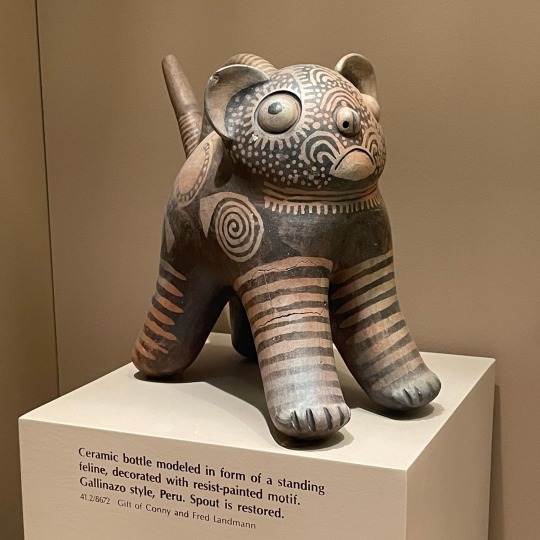
Ceramic bottle modeled in the form of a standing feline, decorated with resist-painted motif.
Gallinazo style (aka Virú culture), NW Peru, Early Intermediate Period, c. 200 BCE - 600 CE.
Spotted at the American Museum of Natural History NYC.
PS: this vessel may depict the Peruvian subspecies of Pampas Cat aka Northern Colocolo (Leopardus colocola garleppi). The Andean Mountain Cat (Leopardus jacobita) is also often suggested, but their range is more southern and higher elevation than where the Virú were? Also note the stripier legs on the Colocolo similar to the ceramic:
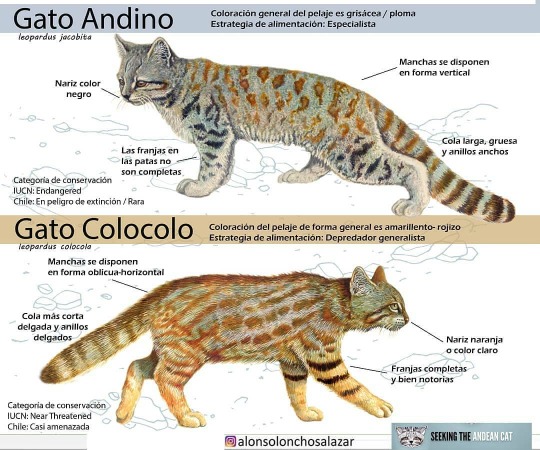
#cat#cats in art#feline#ceramics#effigy vessel#pre-conquest#Peruvian att#South American art#Indigenous art#Gallinazo#Virú#American Museum of Natural History#museum visit#Caturday#animals in art#Pampas Cat#Colocolo#Andean Mountain Cat#wild cats#mammalogy#zoology#species ID#ID#infographic#Peruvian art
2K notes
·
View notes
Text
Wonderful news from the Cyclops Mountains of West Papua today with the rediscovery of Attenborough's long-beaked echidna (Zaglossus attenboroughi)!

(Image credit: Expedition Cyclops)
Previously known a single specimen collected in 1961, Attenborough's long-beaked echidna has long been one of the world's most elusive mammals. Recognised as a distinct species in 1998, an expedition to the Cyclops Mountains in 2007 failed to observe the echidna but found evidence of recent diggings and foraging activity which, alongside local knowledge, implied that the species still survived in those remote mountain forests.
Finally, just a few months ago, a new expedition into its remote mountain home by Expedition Cyclops caught the first ever footage of Attenborough's long-beaked echidna in the wild, which is also the first time it has been seen by scientists in over 60 years. In a remarkable stroke of luck, the echidna was captured on the last of over 80 camera traps on the final day of the trip!
Attenborough's long-beaked echidna is the most distinctive of the three species of long-beaked echidna thanks to its smaller size, shorter, straighter beak and reddish-brown fur. Its habits are virtually unknown, but its differently shaped beak may suggest that it differs in diet and feeding habits from the other two long-beaked echidna species. It appears to be endemic to the highest elevations of the Cyclops Mountains, which are steep, extremely rainy and treacherous to explore, hence why it remained hidden for so long.

(Image credit: Expedition Cyclops)
There are only five species of monotreme alive today, the sole living custodians of a lineage stretching back some 200 million years, and this makes each species extraordinarily valuable. Unfortunately, all three species of long-beaked echidna are threatened with extinction, with Attenborough's long-beaked echidna being classed as critically endangered. Losing any species is a tragedy, but for a group as small and precious as monotremes, any extinction would be especially disastrous.
Alongside the rediscovery of the echidna, Expedition Cyclops also made the first record of Mayr's honeyeater (Ptiloprora mayri) in 16 years and discovered dozens of new species of insects, arachnids, shrimp and frogs. Their work documenting the hidden biodiversity of the Cyclops Mountains is ongoing, so if you'd like to follow and support the expedition make sure to visit their website!
https://www.expeditioncyclops.org/
#oceania#papua#west papua#new guinea#wildlife#mammal#mammals#monotreme#monotremes#echidna#echidnas#animal facts#animal news#mammalogy#natural history#my stuff
288 notes
·
View notes
Text
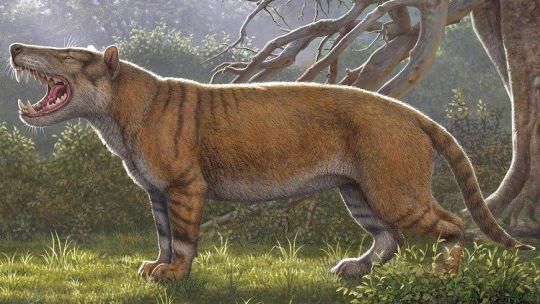
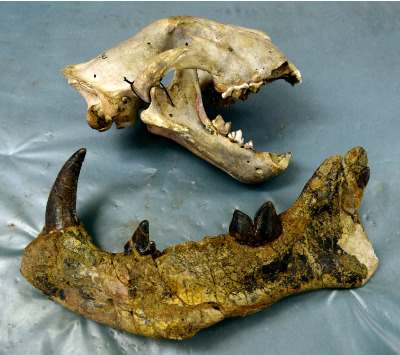
October's Fossil of the Month - Simbakubwa (Simbakubwa kutokaafrika)
Family: Hyena Cat Family (Hyainailouridae)
Time Period: 23-22 Million Years Ago (Early Neogene)
Currently known only from fossilised teeth and lower jaws discovered in Kenya's Messa Bridge fossil site, Simbakubwa kutokaaffrika was originally described as a prehistoric species of hyena before reexamination of fossils housed at the Nairobi National Museum of Kenya led to it being reclassified as a hyaenadont (a member of the extinct order Hyaenadonta, the members of which were generally dog-like animals with similar jaws and teeth to modern hyenas, although their teeth differed from true carnivorans today in that they lacked modified molars used for crushing and tearing seen in animals such as bears and dogs, and seemed to grow their teeth in slower than most modern carnivores.) While the limited variety of Simbakubwa fossils means that much of its biology is a mystery, it is notable among the hyaenadonts because of its size; estimates of its body size based on the size of its jaws suggest that, while most hyaenodonts were comparable to a large dog in size, it was at least as large as a lion, with the most generous estimates suggesting that it may have weighed as much as 1,500kg/3,307lbs (surpassing even modern Polar Bears in size,) although as the more complete fossils of related species suggest that members of the "hyena-cat" family of hyaenodonts that Simbakubwa belonged to had extremely large heads compared to their bodies it is unlikely that it actually reached such as size. Based on the shape of its teeth and the presumed strength of its jaws it is likely that Simbakubwa was purely carnivorous and fed on large mammals such as rhinoceros and gomphotheres (extinct relatives of modern elephants,) although based on the lack of any preserved teeth showing adaptations for crushing it is unclear if members of this species also fed on bones as other hyaenodonts and modern hyenas are known to do. While the circumstances of Simbakubwa's extinction are unclear, it is plausible that as the earth gradually became cooler and drier as it approached a series of "ice ages" in the later neogene resources became scarcer and large carnivores were among the first species to be affected by this. While the binomial names of most species are derived from Greek and/or Latin, Simbakubwa kutokaaffrika is Swahili, translating roughly to "great lion from Africa."
--------------------------------------------------------------------------
*Note - The second image above shows a Simbakubwa lower jaw (bottom) compared to a modern Lion skull (top.)
Image Sources: https://commons.wikimedia.org/wiki/File:Simbakubwa-kutokaafrika_2.jpg
and
https://www.nationalgeographic.com/science/article/new-species-ancient-carnivore-was-bigger-than-polar-bear-hyaenodonts
#Simbakubwa#hyeanodont#hyaenodonts#zoology#biology#paleontology#mammalogy#prehistoric wildlife#animal#animals#wildlife#African wildlife#African fossils#fossil#fossils#mammal#mammals#prehistoric animals#prehistoric mammals
245 notes
·
View notes
Text

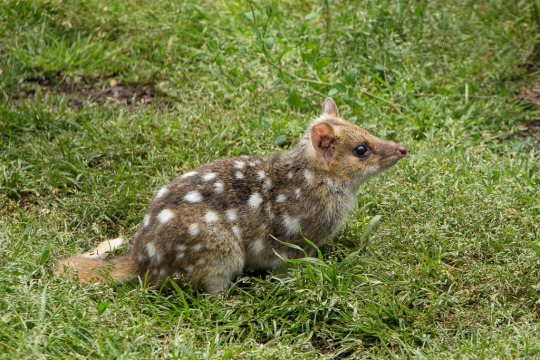


earth fact time. meet the quoll. they're marsupials! they're carnivorous! they're super cute! and there have been 111 cases recorded of them eating human bodies and human corpses!
they used to be abundant in australia before european settlement, but now some species have seen a nearly 70% decline. one species has even disappeared completely from the australian mainland.
australian geographic | bush heritage
photos: picasa web albums | guy nœhringer | jj harrison | michael barritt & karen may
#terrestrial#earthposting#facts!#biology#zoology#animal facts#carnivores#animals#australian animals#mammalogy#mammals#marsupials#quolls#northern quoll#eastern quoll#tiger quoll#tw eating people#tw death mention#earth fact no. 19
149 notes
·
View notes
Text

Just the best thing I've seen all week
135 notes
·
View notes
Text
I love being a biology major because all of my professors are fucking nerds I just had a doctor who is teaching me about conservation biology sign off her email with "may the force be with you"
last semester I had a professor that signed all his emails "sessuvium" (which is a species of plant that "goes with the flow" and can grow under intense conditions near oceans in high sodium soil) he also used pokemon in all his powerpoints and talked about his bisexual wizard dnd character while we were out in the field
#zoology#biology#mammalogy#horticulture#zoology major#stem major#biology major#science#all biologists are autistic#that includes me#why else would we study this shit?
35 notes
·
View notes
Text
I love being overwhelmed by zoology. Knowing I'll never know every species, its ecological niche, how it looks and behaviours. Although its a sad thought, it comforts me in the fact there's so much biodiversity that even the most intelligent species ever on earth can't grasp the depth and beauty of the natural world.
61 notes
·
View notes
Photo


A young 9 banded armadillo (Dasypus novemcinctus) I captured at work today. Released unharmed after brief examination. Since these guys are one of my favorite native mammals I will celebrate by posting Fun Armadillo Facts™ .
1. Nine-banded armadillos were unheard of in the United States until the late 19th century, when they crossed the Rio-Grande naturally and were introduced to Florida by humans. Their range has expanded rapidly and they now occupy much of the southern US, and are still spreading.
2. Every nine-banded armadillo you see, at one point in its life, had three identical siblings. The species almost invariably produces quadruplets!
3. They are one of the only animals other than humans to be susceptible to leprosy. With a low core temperature and a long lifespan they are perfect for the bacteria to propagate, and actually suffer it systemically rather than on mainly peripheral tissues the way humans do. You are unlikely to get leprosy from the average armadillo, however.
4. Unlike the smaller three-banded armadillo, the nine-banded cannot roll into a ball. Its methods of escape involve either a surprising rapid run, attempting to dig down to where only its carapace is exposed, or, and this is why so many are hit by cars, leaping 3+ vertical feet in order to startle predators. In the words of zefrank, this is precisely the wrong defense to survive a charging honda, regrettably.
5. They can be litter box trained much like a cat!
6.They once had gigantic prehistoric relatives including Doedicurus and Glyptotherium. Large herbivores reaching the size of small cars. I wish so badly that they remained alive so I could ride one.
I hope you enjoyed these Fun Armadillo Facts™
455 notes
·
View notes
Text


Mountain Beaver (Aplodontia rufa)
(Photos by Tim Donner for Portland Audubon)
359 notes
·
View notes
Text

China's most mysterious wildcat may not be its own species
New study downgrades status of the Chinese mountain cat, sparking concerns about its future
Deep in the alpine meadows of the Tibetan Plateau slinks one of the world's most mysterious felines. The Chinese mountain cat—with its sky-blue eyes, sandy coat, and unusual lack of markings—is so elusive that it wasn't photographed in the wild until 2007. For decades, many have considered the stocky-legged feline the only species of cat native to China. But that may be about to change.
A new genetic analysis of more than two dozen Chinese mountain cats concludes that the creature is not its own species, but rather a subspecies of feline that gave rise to several modern wildcats and the domestic cat. That demotion could hamper efforts to save the vulnerable animal, fears Jim Sanderson, a wildlife ecologist with the conservation group Re:wild who snapped that first photo. "The belief is that if it's not a species, nobody cares."
The new study began as an attempt to figure out whether China had independently domesticated the housecat. Most scholars believe domestic cats arose in the Middle East about 10,000 years ago. But there was evidence that other domestications could have occurred in Asia thousands of years later. Was the Chinese mountain cat involved?
Read more: https://www.science.org/content/article/china-s-most-mysterious-wildcat-may-not-be-its-own-species
134 notes
·
View notes
Text

It’s time for Fossil Friday! Meet the “strong weasel” of the genus Sthenictis. It lived some 12 million years ago during the Miocene. This well-preserved specimen is mounted as it was found during excavations in north-central Nebraska. Although it represents an extinct group, its body form is typical of mustelids. In particular, the elongated trunk, short legs, and large feet are characteristic of living mustelids such as the pine marten.
See it up close in the Museum's Hall of Advanced Mammals! We're open daily from 10 am-5:30 pm. Plan your visit.
Photo: © AMNH
#science#amnh#museum#fossil#natural history#nature#animals#paleontology#weasel#aminals#did you know#fact of the day#mustelid#ancient animals#miocene#mammals#mammalogy
322 notes
·
View notes
Text
#HedgehogWeek 🦔:
All hedgehogs are capable of volvation aka conglobation - aka, they can roll up into an armored ball in defense. 🙂

Hedghog
Egypt, New Kingdom, Dynasty 18, c. 1550–1450 BCE
Faience, diameter 5.8cm
Metropolitan Museum of Art, New York
The Metropolitan Museum of Art, New York: https://metmuseum.org/art/collection/search/544054

Photo via Stocksy United on Pinterest
#hedgehog#volvation#conclobation#mammalogy#zoology#animal defenses#ancient Egyptian art#faience#ceramics#New Kingdom Egypt#ancient art#animal holiday#Hedgehog Week#Hedgehog Awareness Week#Metropolitan Museum of Art New York#animals in art
270 notes
·
View notes
Text
The lesser bilby (Macrotis leucura), less degradingly known as the yallara by the Wangkangurru people, is one of Australia's many many obscure recently extinct mammals. It was last seen alive by western observers in 1931, although based on First Nations knowledge (and a skull found under an eagle's nest) it appears to certainly have survived at least into the 1960s.

(Image credit: Oldfield Thomas’ Catalogue of the Monotremes and Marsupials in the British Museum)
The yallara was smaller and less colourful than the living greater bilby (M. lagotis), hence its description of as the "lesser" of the two species, but what it lacked in stature it made up for in ferocity. Unlike its larger cousin, the yallara was reportedly very aggressive and feisty, with Hedley Finlayson (one of the few scientists to observe the species in life, and the last) writing that they:
"...completely belied their delicate appearance by proving themselves fierce and intractable, and repulsed the most tactful attempts to handle them by repeated savage snapping bites and harsh hissing sounds, and one member of the party, who was persistent in his intentions, received a gash in the hand three quarters of an inch long from the canines of a male."
Although few observations of the species were made in life and much of their ecology remains a mystery, they may also have been more carnivorous than the living greater bilby. Investigations of stomach contents found large quantities of skin and fur from rodents, with only limited seeds and no insect fragments having been ingested. However, this information only comes from a small sample of individuals, so whether or not the yallara was the most predatory of all modern bandicoots will likely remain uncertain. They also differed in behaviour from greater bilbies by always blocking the entrance to their burrow after entering.
The species was only observed by Europeans in the harsh deserts of north-eastern South Australia and the south-east of the Northern Territory, but testimony from Aboriginal peoples indicates it also extended further west into the Great Sandy and Gibson Deserts of Western Australia. Being reported as common when last observed by Finlayson in the 1930s, its decline and extinction appears to have occurred entirely unobserved by western eyes, but it is likely that they were a victim of the usual troubles - invasive species and changing fire regimes.
#we were robbed of feisty bilbies#australian wildlife#wildlife#mammals#marsupials#bilby#lesser bilby#extinct#recently extinct#extinct species#extinction#animal facts#mammalogy#natural history#infodumps#my stuff
128 notes
·
View notes
Text
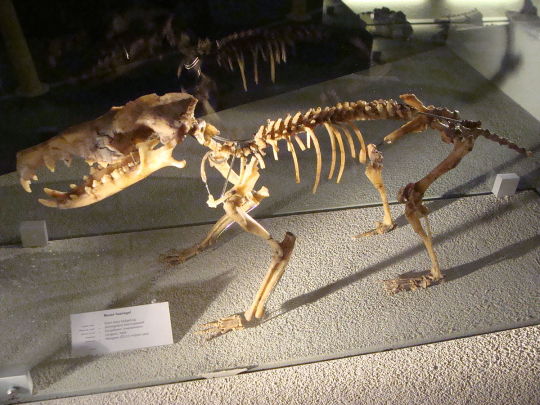

November's Fossil of the Month: Deinogalerix (Deinogalerix spp.)
Family: Hedgehog Family (Erinaceidae)
Time Period: 10-5 Million Years Ago (Late Miocene)
Native to what is now the Gargano region of southeastern Italy (which, as a result of higher sea levels, was an isolated island at the time,) the members of the genus Deinogalerix were relatives of modern hedgehogs comparable in size to small dogs. Lacking defensive spines but possessing long legs and proportionally enormous jaws, it is believed that, in the absence of large carnivores on their home island, the ancestors of this genus' members developed into fast-moving carnivores that may have fed on smaller vertebrates in addition to the invertebrates that make up the bulk of their smaller relatives' diets. The evolutionary phenomenon by which small carnivores isolated on islands gradually become larger, known as insular gigantism, is fairly well documented (being seen in both modern animals such as the Komodo Dragon and numerous extinct species known from fossils found on islands or in areas that were once islands, including a species of eagle-owl sized barn owl, Tyto gigantea, which coexisted with Deinogalerix on what is now Gargano) and is thought to occur in response to a lack of established large predators compared to nearby mainlands. The assumption that Deinogalerix species developed to exploit a lack of competition from similarly-sized predators would also explain their eventual extinction; the Miocene period ended in a major ice age, and as an increase in ocean freezing caused sea levels to fall the island on which Deionogalerix developed would have become more easily accessible from the mainland, possibly allowing for other similarly-sized or larger predators to colonise the former island and outcompete its unique inhabitants - a theory supported by the fact that Tyto gigantea also seems to have gone extinct around this time.
--------------------------------------------------------------------------
Image Sources: https://commons.wikimedia.org/wiki/File:Deinogalerix_koenigswaldi-Naturalis-PeterMaas.JPG
and
https://www.sci.news/paleontology/science-deinogalerix-masinii-new-giant-fossil-hedgehog-italy-01535.html
#Deinogalerix#deinogalerix#hedgehog#hedgehogs#biology#zoology#mammalogy#paleontology#animal#animals#prehistoric animals#wildlife#prehistoric wildlife#prehistoric mammal#prehistoric mammals#fossil#fossils#nature#European wildlife#Italian wildlife
166 notes
·
View notes